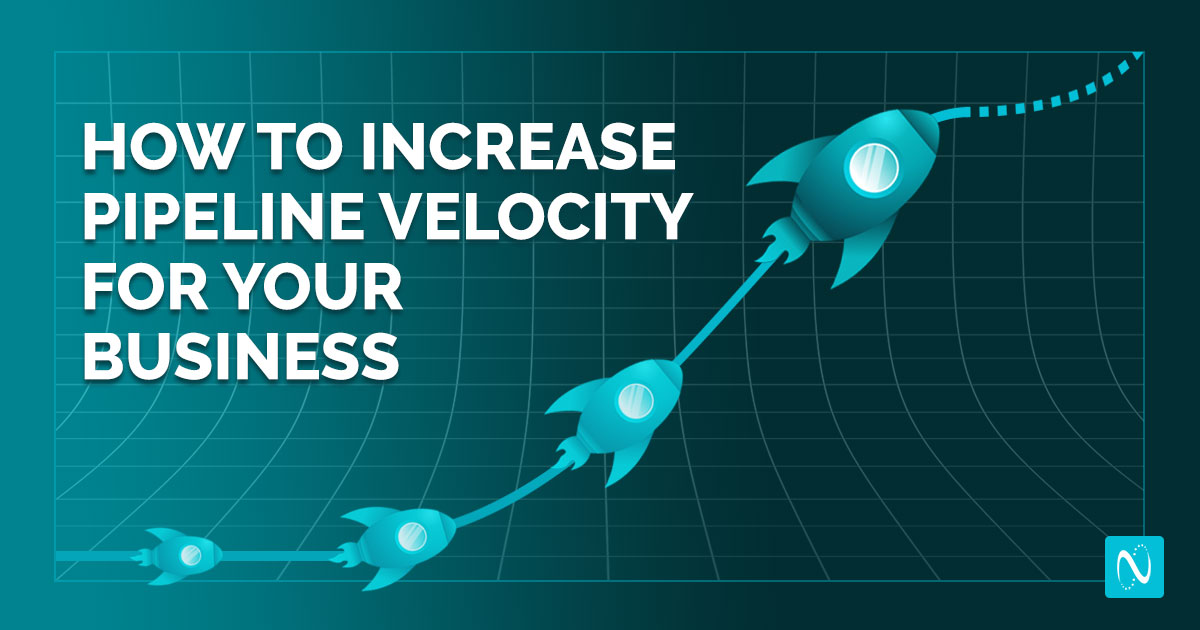If you thought velocity was only fundamental in physics, think again.
Sales pipeline velocity is integral to the health of a company, especially for B2B sales and marketing teams.
A thorough understanding of pipeline velocity is vital for B2B lead generation. It allows you to increase conversions, close more sales, and drive more revenue.
By tracking your current pipeline velocity—and optimizing it—you can create a higher-performing sales process that improves your bottom line.
In this post, we’ll explore the role of pipeline velocity in B2B sales and marketing, along with actionable tips to increase pipeline velocity for your business.
What is pipeline velocity in B2B sales and marketing?
Pipeline velocity in B2B sales and marketing refers to the speed with which prospects move through the sales pipeline, also called the sales funnel.
Tracking for pipeline velocity begins the moment a lead demonstrates an expressed need and ends when they finally convert. Like an actual pipeline, any barriers within the sales funnel will slow down the pipeline velocity. Fewer barriers in the pipeline equal faster conversion speeds.
For B2B sales and marketing teams, achieving higher pipeline velocity means faster execution on profitable business objectives.
What is the goal of pipeline velocity?

Photo by Darya Sannikova via Pexels
The goal of pipeline velocity is to have prospects enter and successfully exit the sales funnel as quickly and efficiently as possible.
However, for sales and marketing teams (even product development teams), pipeline velocity can also reveal where leads get stuck while moving through the funnel. It helps teams visualize hurdles within the nurturing and onboarding processes to identify and eliminate them.
Likewise, because pipeline velocity relies on real-time funnel data, continuous measuring helps improve the accuracy of sales forecasting.
Here’s how to increase your sales velocity pipeline
The more you increase your sales velocity pipeline, the more leads you can enter into the sales funnel (and the faster you can convert them), helping to meet and exceed sales objectives easier. Consider these ten practical steps to increase the pipeline velocity for your business.
- Identify where and when prospects exit the pipeline
Before you can increase your pipeline velocity, you need to determine exactly where prospects are dropping out of the funnel and slowing it down in the first place.
Evaluate the key metrics associated with each stage of your pipeline, such as the number of qualified leads and win rate, to identify the weakest links.
From here, investigate the reasons why prospects are leaving—is it the price of the product? Do the features not align with the marketing?
Once you discover why leads are exiting the pipeline, you can address it. For instance, you may need to craft new marketing materials that better spotlight your product’s features.
- Minimize data silos between different teams

Photo by Deneen LT via Pexels
Because your sales pipeline is reliant on current data, it’s vital to minimize data silos between different departments to increase your pipeline velocity. Anytime different teams have access to differing data, the chances of informational inaccuracies skyrocket.
Not only can these inaccuracies impact sales success, but they can also waste valuable time and resources. Instead, enact proper data sharing with a centralized customer relationship management (CRM) tool.
For example, you can quickly minimize data silos by investing in a shared CRM that standardizes customer data across multiple departments.
- Eliminate points of friction in the sales cycle
Now that you’ve identified the weak links in your sales pipeline and have better informed each team, you can locate and eliminate points of friction in the sales cycle.
Picture that you have ten qualified leads in the pipeline with an average sales cycle of 20 days. Seven of the leads converted within that time, but three have stalled due to friction in the sales cycle, such as multiple discovery calls split between various sales reps and account managers.
To make the sales cycle seamless, ensure that you get the sales handoff right and that leads don’t have to repeat their pain points during numerous interactions.
- Create an ideal customer profile (ICP) to simplify targeting

NetLine’s Audience Explorer is a terrific way to better identify who your best audience and prospects could be.
If your organization harnesses account-based marketing (ABM) for the sales cycle, you’re likely familiar with the concept of an ideal customer profile (ICP).
An ICP consists of the behavioral, firmographic, and environmental characteristics of accounts that can become an organization’s most valuable customers. Creating an ICP with the information from your current sales funnel can help simplify targeting to easily connect with best-fit prospects.
By using a detailed ICP, you can better personalize marketing messages on the path to purchase that help unclog your sales pipeline of unqualified leads faster. (NetLine’s Audience Explorer is one of the best tools to use to review your ICP.)
- Focus on higher-quality leads
With an ICP prepared for sales and marketing teams, you can focus efforts on targeting high-quality leads—even if that means attracting fewer total leads.
High-value accounts protect against wasted resources spent on bad leads who drop off at the top of the sales funnel or midway through the pipeline. Beyond an ICP for ABM, you can also source high-quality leads by fine-tuning your top-of-funnel marketing channels.
Assess which touchpoints your most valuable accounts accessed to enter the marketing funnel and ramp up similar initiatives, such as LinkedIn ads or PPC campaigns.
- Improve your win rate percentage
As the name might suggest, your win rate percentage is the number of deals you closed in relation to the number of qualified leads in your pipeline. For instance, if you closed 30 deals out of 100 last month, your win rate would be 30%.
For most B2B businesses, a win rate above 50% is ideal. The higher your win rate, the better your pipeline velocity. To improve your win rate, you must focus on nurturing leads with expressed intent to buy. Simple tactics to nurture high-quality leads include defining clear next-steps for sales reps and involving the primary decision-maker as early in the pipeline as possible.
- Shorten the length of your sales cycle

Photo by Stas Knop via Pexels
Along with improving your win rate percentage, shortening the length of your sales cycle is integral to increasing pipeline velocity for your business. The best way to shorten your sales cycle is to reduce the gaps between the various steps in the sales process.
For instance, automate repetitive tasks for sales and marketing teams to accelerate their campaigns. Set agreed-upon goals like scheduling a date for a demo for each sales call.
Likewise, make it easy for leads to convert from any device. Offer mobile-friendly contracts and optimize your lead generation forms for all devices.
- Provide incentives to quicken conversions
Though shortening the length of the sales cycle is essential for increasing pipeline velocity, it’s not always easy. To help quicken conversions, consider providing incentives that sweeten the deal.
Price, for example, can be a major point of friction in the sales funnel.
Advise sales reps to be clear about pricing as early in the pipeline as possible and cushion the potential negative impacts of pricing with beneficial incentives, such as product discounts that can speed up conversions.
Experiment with time-sensitive incentives—such as limited-time promotions on pricing—to help further decrease the average length of your sales cycle and boost your pipeline velocity.
- Increase your average deal size
While pipeline velocity hinges on the speed with which prospects move through the sales funnel, it does take into consideration the average deal size for your business. In fact, boosting your average deal size can help with increasing your pipeline velocity (but more on that math in just a moment).
To enhance your typical deal size, focus on your prospects’ noted pain points and determine how your business can provide more value with each transaction.
If software setup has been a typical issue for previous customers, offer after-sales services like product training to drive up your average deal size.
- Follow-up and remarket to stagnant leads
As with any B2B sales and marketing initiative, increasing the pipeline velocity for your business always benefits from remarketing to qualified but stagnant leads. It’s no secret that sourcing new leads is more expensive (and difficult) than retaining current ones, so remarketing to pre-qualified leads can be a lucrative process.
To take a proactive approach to remarketing, be sure to utilize your organization’s shared CRM to keep track of all active leads. From here, keep your business top of mind for buyers by creating a segmented email list, following up in a timely manner, and sending over helpful resources like whitepapers.
4 key sales pipeline velocity metrics to track

Photo by Jeremiah Buchanan via Pexels
To calculate your sales pipeline velocity, you must track four key metrics:
- Number of Sales Qualified Leads (SQLs) in the pipeline. Rather than the number of total leads (many of which will not convert), track the quality of leads who have already interacted with your marketing materials and explicitly expressed interest in your business’s service or product.
- Sales win rate percentage. Monitor the number of sales won in relation to the total number of SQLs in the pipeline over a set period, such as one month, to calculate your win rate.
- Average deal size (deal value). Track the monetary value of each sale completed (closed-won deals) over a set time period to determine the average deal size of leads in your current sales pipeline.
- Length of the sales cycle. Assess the number of days it takes for your sales and marketing teams to move SQLs from the early stages of the sales pipeline through to conversion.
Of the above four metrics, your sales cycle is the only factor you do not want to increase when attempting to boost pipeline velocity for your business. The longer your sales cycle, the longer it takes to convert. Instead, aim for creating a more efficient sales process to shorten the sales cycle.
On the other hand, even minor improvements in your number of SQLs, win rate percentage, and average deal size can increase your general pipeline velocity. Take a look at the formula in action.
Sales pipeline velocity formula
Now that you understand which key sales pipeline velocity metrics to track, it’s time to put them to use. Like calculating velocity in physics, calculating pipeline velocity for B2B businesses means you must find the rate of change of position in relation to a specific period of time.
Here’s what you’ll need to do:
First, multiply the number of SQLs in your pipeline by your average deal size and the average win rate percentage for your sales team. Next, divide the result by the number of days in your sales cycle.
As a formula, calculating sales pipeline velocity looks like this:
Pipeline Velocity = (# of SQLs x $ Average Deal Size x % Win Rate) ÷ (# of Sales Cycle Days)
What is an example of pipeline velocity?
To better understand the sales velocity formula in action, consider a B2B company that had 10 SQLs in their sales pipeline last month. The win rate for the SQLs was 40% with an average deal size of $5,000. This company had a sales cycle that lasted 25 days.
In this case, the business’ sales velocity equation would look like this:
Pipeline Velocity = (10 x $5000 x 40%) ÷ (25 days)
Pipeline Velocity = (20000) ÷ (25 days)
Pipeline Velocity = $800
So, according to the above formula, this B2B company has a pipeline velocity of $800.
How NetLine can help with your pipeline velocity rate
If you are looking to increase your pipeline velocity, a great first step is to focus on sourcing more intent data.
NetLine’s INTENTIVE is the only first-party buyer-sourced intent data platform. With 11,000+ topics, 329k keywords, and 100 million activities via Informa events, the platform is primed to support marketers and sellers, alike.
